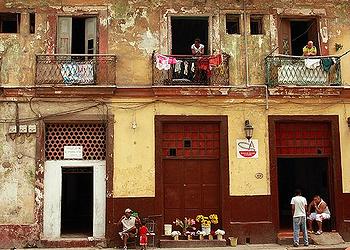
HAVANA, Cuba, December 26, 2012 (ENS) – A rise in cholera cases in the Cuban capital Havana is being traced back to parts of the country hardest hit by Hurricane Sandy, the worst natural disaster to strike Cuba in half a century.
The Cuban government is saying little about reported cases of cholera. But doctors who have recorded new cases of the disease during recent house-to-house inspections say the health ministry has declared a state of alert in the Jesús María and Belén communities of Habana Vieja municipality.

Habana Vieja – Old Havana – is a popular tourist area in the city center.
“They’ve found 47 cases in Habana Vieja municipality,” said a doctor, who requested anonymity. “Thirty-three of them originate from the eastern provinces.”
The implication is that the individuals carrying cholera may have contracted it in Cuba’s eastern regions as a result of the flooding caused by Hurricane Sandy in late October.
Standing water is an ideal breeding-ground for cholera, an intestinal disease transmitted by contaminated liquid and food, and many cases have been reported in provinces like Holguín, Santiago de Cuba, Las Tunas and Guantánamo.
The authorities have taken steps to address the new cases in Havana by setting up specialized hospital wards, cleaning up streets and buildings in the Jesús María and Belén communities, and distributing medicines that prevent dehydration.
Health staff have been driving around Old Havana issuing notifications by loudspeaker, telling people what precautions to take, urging them not to try to cure themselves, and announcing training sessions where medical staff will be taught how to contain the “epidemic.”
The authorities are also taking action to stop sales of food that fall short of health and hygiene standards, according to a health worker involved in the cholera identification and public information campaign in Habana Vieja municipality.

All the same, the health worker said, he feared “rising numbers of cases.”
A local doctor said he suspects the government is holding off on officially announcing a cholera outbreak because it might deter tourists from visiting Havana’s old town.
In three provinces – Santiago de Cuba, Las Tunas and Guantánamo – residents say some municipalities have been placed under quarantine.
“The public health ministry is here in Guantánamo because it placed the La Tinta community under quarantine three days ago, following a new outbreak of cholera,” Juan Luis Bravo Rodríguez, a correspondent for the Hablemos Press Information Centre in Guantánamo City, said on November 16.
In eastern Cuba, the authorities are continuing to take steps to deal with cholera. In Holguin province, doctors at the Vladimir Lenin Hospital say they are admitting three to five new cases a day.
The rising incidence is a cause for concern for Holguín residents like Efraín Méndez, who says that while the health authorities are acting to curb the spread of cholera, they are not providing enough information to the public.
Méndez said the authorities have placed two of Holguín’s municipalities, Mayari and Moa, under quarantine because of the number of cholera sufferers in need of medical help. They are also imposing large fines on black-market traders in seafood and vegetables, as substandard products can help the disease spread.
One eyewitness spoke of police and security-service officers are guarding infectious disease wards at clinics and hospitals to prevent news of the scale of infection leaking out.
After visiting his wife at the Ernesto Guevara Hospital in Las Tunas, Livan Monteagudo Rivero said, “The serious cases are taken to the observation ward in Guevara, where there are more than 20 cases. They post a police or security officer at the door to the ward so that no one can enter and leave with information.”
{Information provided by Hablemos Press and independent journalist Lisbán Hernández. A version of this article was first published by the Institute for War and Peace Reporting on December 24, 2012}
Copyright Environment News Service (ENS) 2012. All rights reserved.
© 2012, Environment News Service. All rights reserved. Content may be quoted only with proper attribution and a direct link to the original article. Full reproduction is prohibited.
